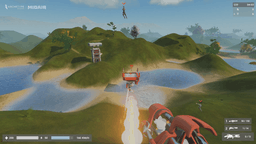Midair (video game)
| Midair | |
|---|---|
 | |
| Developer(s) | Archetype Studios |
| Publisher(s) | Archetype Studios |
| Engine | Unreal Engine 4 |
| Platform(s) | Microsoft Windows |
| Release date(s) | Q4 2017 |
| Genre(s) | First-person shooter |
| Mode(s) | Multiplayer |
Midair is an upcoming free-to-play first-person shooter by Archetype Studios. The game is heavily influenced by the Tribes series of video games, emphasizing freedom of movement with jetpacks and skiing, while also featuring large open maps and vehicles. The game is currently under development on Unreal Engine 4, and is in the pre-alpha stage of development with a full release planned for Q4 2017.
Gameplay

Midair features similar mechanics from previous Tribes games such as jetpacks and a mechanic the developers call skating, which allows the player to glide across the terrain. Players will have a choice of using either Light, Medium, or Heavy armors. Weapons include a Spinfusor-like weapon currently referred to as the Ring Launcher, as well as a Grenade Launcher and Chain Gun. A Mortar and Sniper Rifle are featured as well. The developers have stated that they are aiming to include most of the traditional weapons from the Tribes franchise, as well as some new ones.
A 3/4/5 weapons system similar to Starsiege: Tribes and Tribes 2 is planned; 3 weapons for Light armor, 4 weapons for Medium armor, and 5 weapons for Heavy armor. No automatic health regeneration is present at the moment or currently planned. Players will be able to equip certain abilities and items, such as deployable sensors and turrets. Aesthetically the game has been compared to Firefall and WildStar; very bright and colorful, along with some form of cel shading effect.
Midair will feature both a server browser and match-making system.[1] The developers have also emphasized the importance of user-made content, and will include map making tools for the community and a system to deliver community maps sometime after release. Public matches will see team-sizes similar to Tribes: Ascend's 16v16, while competitive team sizes will vary between 5v5 and 11v11, depending on the game mode.[2]
Monetization
Midair will feature both unlocks and a progression system. As players progress they will earn unlocks such as weapons, packs, items, and deployables. The time needed to unlock these items has yet to be revealed, though the developers have stated that their goal is to "get everyone up to speed quickly with each role in the traditional CTF game without feeling super disadvantaged, while also encouraging players to keep playing to unlock new and cool things to do in the game over time."[3]
Development
The project originally began as a port of Legions: Overdrive to the Unity game engine in 2012 by former Legions: Overdrive developers. After taking into consideration how much time and effort would be required, the team decided to make a full-fledged sequel to Legions: Overdrive. However, in 2013 the developers decided to change plans and develop a new game altogether.[4]
After working with Unity for roughly a year the developers switched to Unreal Engine 4 shortly after the engine's release in March 2014.
On August 15, 2014, Archetype Studios was officially announced as the development studio for the then-titled Project Z, along with an official website and concept art for the game. Midair made its first public unveiling to those who attended the studios (off-site) presentation during PAX Prime 2014 on August 30, 2014.[5]
On April 26, 2015, the game was officially renamed to Midair. The official website was launched,[6] and a teaser trailer was released.[7]
On August 29, 2015, a pre-alpha build was available to play during PAX Prime 2015.
On December 22, 2015, a Steam Greenlight campaign was launched for Midair. The first official gameplay trailer was also released. On December 29 they achieved Greenlight status.[8]
On May 5, 2016, Archetype Studios launched a Kickstarter campaign for Midair with a goal of $100,000. On June 4 the campaign ended with $128,000.[9]
References
- ↑ Q&A Round-Up: Dedicated Servers vs Matchmaking
- ↑ "The Z Axis" Podcast #7 - T:A Patch, Midair Greenlight, New Game Roundup
- ↑ Monetization and Progression in Midair
- ↑ The Future of Legions - Part Two
- ↑ Archetype Studios and Project Z
- ↑ Archetype Studios Facebook
- ↑ Midair Teaser
- ↑ Midair Has Been Greenlit!
- ↑ Midair on Kicktraq